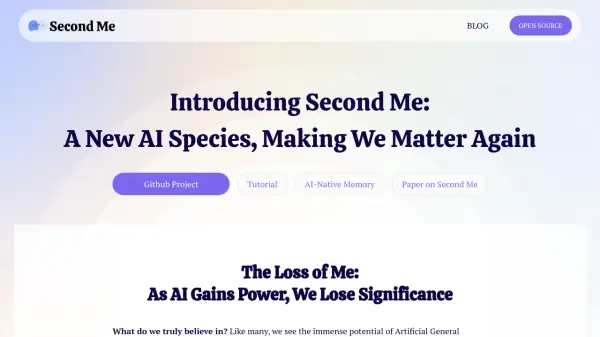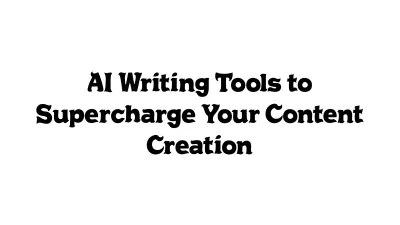What is Second Me?
Second Me addresses the concern of losing individual identity as Artificial General Intelligence (AGI) advances. It offers an open-source AI identity system designed to create deeply personalized AI agents that represent, rather than replace, the user. This platform allows individuals to build a digital 'Second Me' based on their unique experiences, preferences, and thinking patterns, ensuring their distinct identity is preserved and empowered within the evolving AI landscape.
Utilizing technologies like Hierarchical Memory Modeling (HMM) for adaptive memory and Me-alignment for deep personalization, Second Me aims to understand users better than traditional methods. It operates on a decentralized framework (Second Me Protocol - SMP), enabling AI entities to interact peer-to-peer while maintaining user control over personal data through local operation options. This approach fosters a secure, interconnected network where individual AI selves can collaborate and create value without compromising privacy.
Features
- Personalized AI Agent Creation: Build AI entities based on your unique identity, experiences, and thought patterns.
- Hierarchical Memory Modeling (HMM): Employs a three-layer memory structure for adaptive learning and pattern recognition.
- Me-alignment Technology: Uses reinforcement learning for deep personalization, enhancing user understanding.
- 100% Privacy & Local Operation: Option to run locally, ensuring complete control over personal data.
- Decentralized Network (SMP): Enables secure, peer-to-peer interaction between independent AI entities.
- Roleplay Framework: Allows the AI self to adapt its presentation based on context while maintaining core identity.
- Open-Source Platform: Fosters community development and transparency.
Use Cases
- Creating a persistent digital representation of oneself.
- Preserving personal identity and values in the age of AI.
- Building personalized AI agents for specific tasks or interactions.
- Participating in decentralized AI networks and agent economies.
- Automating personalized tasks while maintaining user control and privacy.
- Exploring multifaceted digital self-representation across different contexts.
FAQs
-
How does Second Me ensure privacy?
Second Me can run locally, giving users complete control over their personal data. It also uses a decentralized network (SMP) for peer-to-peer communication, keeping information within the user's control and shared only with explicit permission. -
What makes Second Me's personalization different?
It uses Hierarchical Memory Modeling (HMM) and Me-alignment technology, based on reinforcement learning, which reportedly enhances user understanding by capturing unique preferences, patterns, and decision-making habits. -
Is Second Me open source?
Yes, Second Me is described as a fully open-source project, encouraging developer creativity and community involvement. -
What is the goal of Second Me?
The mission is to safeguard individual identity in the AI age by creating personalized AI agents that represent the user, allowing them to participate in the emerging agent economy while retaining control over their data and digital self. -
Can a Second Me adapt to different situations?
Yes, it utilizes a roleplay framework allowing the AI self to present different versions based on the context (e.g., professional vs. casual), similar to human behavior, while maintaining the core authentic identity.
Related Queries
Helpful for people in the following professions
Second Me Uptime Monitor
Average Uptime
99.86%
Average Response Time
213.47 ms
Featured Tools
Join Our Newsletter
Stay updated with the latest AI tools, news, and offers by subscribing to our weekly newsletter.











